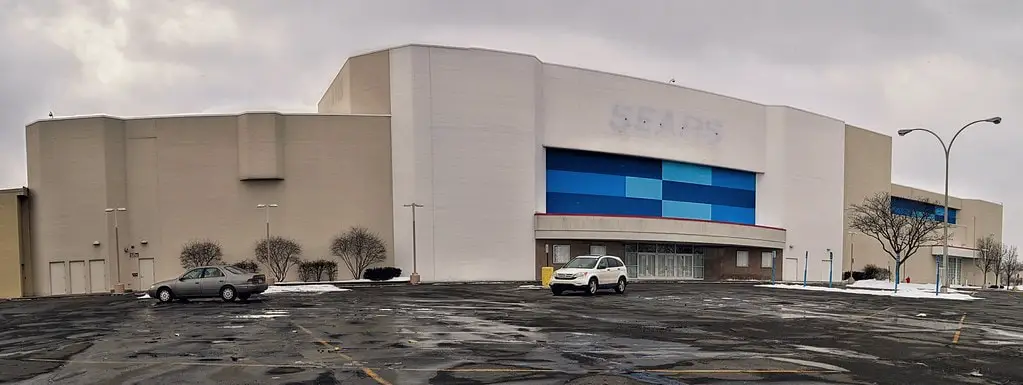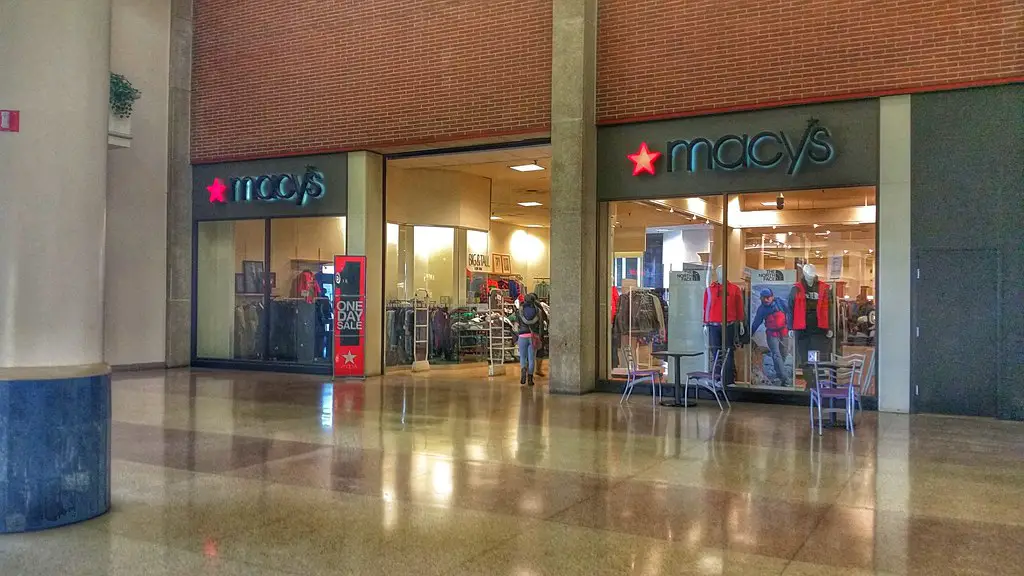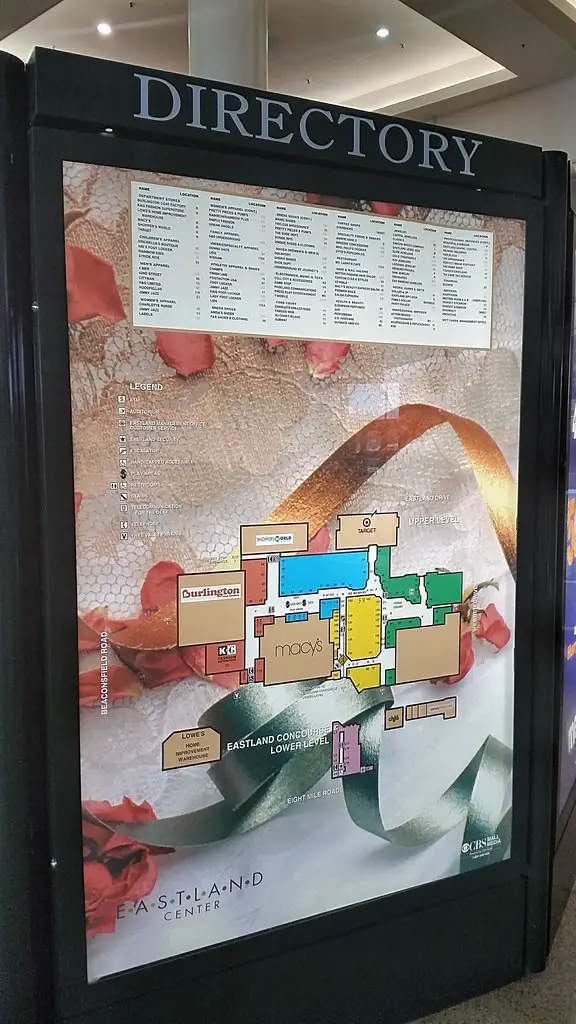The Inception and Evolution of Eastland Center Mall in Harper Woods, MI
The Beginnings of a Retail Landmark
In 1957, the city of Harper Woods, Michigan, witnessed the birth of a key retail destination: Eastland Center Mall.
Developed by the J.L. Hudson Corporation, this mall marked a significant milestone in the landscape of American shopping centers.
Renowned architect Victor Gruen, known for his innovative approaches to mall design, crafted the layout of Eastland Center.
The mall initially boasted about a million square feet of retail space, creating a haven for shoppers and a bustling hub for the community. Its doors revealed a world of shopping possibilities, with 5-level J.L. Hudson.
Architectural Brilliance and Expansive Growth
Victor Gruen’s architectural prowess was on full display at Eastland Center. His design philosophy went beyond mere shopping; he envisioned malls as social environments where people could gather, interact, and enjoy leisure time.
Eastland Center embodied this vision with its spacious corridors filled with natural light and diverse retail, dining, and entertainment options.
The mall saw several expansions and renovations as years passed, adapting to the ever-evolving retail landscape. New stores and services were continually added, keeping the mall fresh and relevant.
A Commercial Hub in Harper Woods
Eastland Center quickly became more than a shopping center; it was a commercial hub, a meeting place for friends and families, and a significant part of the Harper Woods community.
As one of the first malls in Michigan, it set a standard for others to follow. The mall’s evolution over the years reflected broader trends in retail and consumer behavior.
It became a landmark for shopping and things to do in Harper Woods, Michigan. The mall’s success story is a testament to the foresight of its developers and the lasting appeal of well-designed retail spaces.
Eastland Center’s Expansion and Transformation Through the Decades
Dynamic Growth and Retail Evolution
As the years rolled on, Eastland Center in Harper Woods, MI, witnessed a dynamic phase of growth and transformation.
The mall, which had already established itself as a premier shopping destination, went through several expansions to accommodate an increasing number of retailers and shoppers.
USA Quiz
How many questions would you like?
These expansions responded to the growing demand for more diverse shopping experiences. The mall’s footprint broadened with its variety of stores and services.
This period saw the introduction of popular retail chains and the departure of others, mirroring the changing tastes and trends in the retail world. Each new store brought flavor to the mall, making it a vibrant and ever-evolving place.

Architectural and Commercial Innovations
The 1980s and 1990s were particularly significant for Eastland Center, bringing notable additions and changes.
The introduction of a food court and a movie theater in 1985 marked a shift towards creating a more comprehensive entertainment experience for visitors.
These additions were not just about expanding the retail mix; they were about transforming the mall into a community space where people could dine, relax, and be entertained.
The mall’s architecture played a crucial role in facilitating these changes, with its design evolving to accommodate these new features while maintaining a welcoming and accessible environment for all.
Reflection of Retail Trends and Consumer Preferences
Throughout this period of expansion and change, Eastland Center remained at the forefront of the retail revolution in Harper Woods, MI.
The ebb and flow of different stores throughout the 1980s and 1990s reflected the broader shifts in consumer preferences and retail trends.
The mall was a barometer of sorts, indicating the health and direction of the retail sector.
As a shopping hub, it continued to draw people from all over the region, cementing its place as a key commercial and social landmark in Harper Woods.
| Year | Event |
|---|---|
| 1975 | Enclosure of Eastland Center; Opening of JCPenney as a new anchor. |
| 1985 | Addition of a food court and movie theater in the eastern wing. |
| 1980s | Opening of MainStreet department store at the mall. |
| 1989 | Acquisition and renaming of MainStreet by Kohl’s. |
| 1993 | Eastland Center undergoes a significant renovation and expansion, including introducing Montgomery Ward as an anchor. |
| 1995 | Closure of Kohl’s store at Eastland Center. |
| 1996 | Target takes over the space previously occupied by Kohl’s. |
| 1998 | Closure of Montgomery Ward. |
| 2000 | Closure of JCPenney. |

Challenges and Changes in the 2000s at Eastland Center
Navigating Through a New Era
The turn of the millennium marked a challenging phase for Eastland Center. As the 2000s began, the mall, like many others across the country, faced significant changes in the retail landscape.
One of the first major shifts was the closure of Montgomery Ward in 1998, which left the mall at 78% occupancy.
This event signaled a broader trend of department store closures nationwide, posing a challenge for Eastland Center.
Despite these hurdles, the mall continued to evolve, welcoming new stores and undergoing various renovations.
These changes reflected a continuous effort to adapt to the shifting preferences of consumers and the evolving demands of the retail industry.
Renewal and Reinvention
During this period, Eastland Center saw a series of renovations under different management groups, each bringing their unique vision.
In 2001, Hudson’s, a long-time anchor, rebranded to Marshall Field’s, signifying a shift in retail branding and consumer perception.
The mall also welcomed Sears in 2003, taking over JCPenney’s previously occupied space. These changes were part of a broader strategy to keep the mall relevant and appealing to shoppers.
Additionally, the redevelopment of the mall’s external areas, including constructing a Lowe’s store, demonstrated a commitment to diversifying the mall’s offerings beyond traditional retail.

Adapting to the Changing Retail Environment
Throughout the 2000s, Eastland Center continued to adapt to the rapidly changing retail environment.
This decade was marked by significant shifts in consumer behavior, with the rise of online shopping and changing shopping habits. Eastland Center responded by continually updating its mix of stores and services.
The mall’s ability to adapt and reinvent itself during this time was crucial in maintaining its status as a key shopping destination in Harper Woods, MI.
Decline and Closure in the 2010s of Eastland Center
The Onset of Decline
The 2010s marked a significant challenge for Eastland Center, reflecting a broader trend affecting malls across the United States.
This decade witnessed a series of closures of key anchor stores that had once been the lifeblood of the mall.
Sears, a long-standing retail giant, closed its doors in 2013, followed by Macy’s in 2017 and Target and Burlington in 2018.
These closures were not just a loss of stores but a symbol of the shifting retail landscape. They significantly impacted the mall’s foot traffic and overall appeal, leading to a noticeable decline in vibrancy and economic health.
The Implications of Major Store Closures
The departure of these anchor tenants had a domino effect on the mall’s ecosystem. As these large stores vacated, the attraction for smaller retailers and shoppers diminished, decreasing the mall’s overall occupancy and vitality.
The closures reflected a shift in consumer shopping habits, with an increasing preference for online shopping and a decline in the traditional mall-going experience.
Eastland Center, once a bustling hub of activity, struggled to attract the same level of patronage it had enjoyed in previous decades.

The End of an Era and Plans for Redevelopment
By 2021, the situation led to a pivotal decision: selling Eastland Center to NorthPoint Development. The new owners planned to demolish the mall and repurpose the site for industrial and warehouse use.
This marked the end of an era for Eastland Center as a retail destination. The mall’s interior closed in November 2021, with only a few stores, like K&G and Shopper’s World, remaining open briefly.
This transition signified a significant shift in the use of the space, moving away from retail and towards industrial development, in line with evolving economic and commercial needs.
A New Chapter: Eastland Commerce Center
From Retail Hub to Industrial Complex
In July 2022, a new chapter began for the former site of Eastland Center with the groundbreaking of the Eastland Commerce Center.
This marked a significant transformation from a retail hub to a $94 million industrial complex. The development plan for this site is ambitious and indicative of the changing economic landscape.
The first building, a 295,000-square-foot structure, was completed by early summer 2023. Along with two other buildings, constructed later, the Eastland Commerce Center is poised to become a new focal point for business and commerce in Harper Woods, MI.
A Future of Opportunities
The Eastland Commerce Center represents a shift towards a more diversified and modern economic infrastructure.
The site will offer 1,031,000 square feet of speculative flex warehouse space upon completion. This new development is not just a replacement for the old mall; it’s a reinvention of the area to meet contemporary commercial needs.
The project is expected to create numerous job opportunities during and after construction. This redevelopment is a clear sign of adapting to the evolving demands of the economy and the local community.
Revitalizing the Local Economy
The transformation of the Eastland Center into the Eastland Commerce Center is a significant step in revitalizing the local economy.
This redevelopment is expected to bring a new wave of energy and economic activity to Harper Woods, MI.
Creating 250 construction jobs and 560 permanent jobs upon completion positively impacts the local job market.
The Eastland Commerce Center is set to become a key player in the industrial and commercial landscape of the area, offering new opportunities for growth and development.
Eastland Center’s Cultural and Social Impact
“The Lion and Mouse” Sculpture: A Symbol of Resilience
One of the most iconic features of Eastland Center was “The Lion and Mouse” sculpture, crafted by Marshall Fredericks.
Installed in 1957, this nine-foot artwork became a centerpiece and a symbol of the mall’s cultural identity. Interestingly, the mouse part of the sculpture was stolen multiple times over the years, only to be replaced each time.
This cycle of loss and renewal mirrored the resilience and evolving nature of Eastland Center itself.
The return of the original mouse in 2007 by the person who had taken it decades earlier added a fascinating chapter to the mall’s history, further enriching its cultural legacy.
A Reflection of Community Challenges
Eastland Center also witnessed its share of challenges, particularly concerning safety. The mall became a site for several violent incidents, including shootings and gang-related activities.
These events, unfortunately, cast a shadow over the mall’s image and affected the perception of safety in the surrounding areas.
The violence at Eastland Center brought to light broader issues within the community, emphasizing the need for enhanced security measures and community engagement to address these challenges.
Architectural Legacy of Victor Gruen
The architectural design of Eastland Center, envisioned by Victor Gruen, played a significant role in its impact as a social space.
Gruen’s innovative approach to mall design went beyond creating a retail space; he aimed to craft an environment where people could gather, socialize, and enjoy their time.
His vision brought to life an area that was more than just a collection of stores – it was a community hub.
The spacious corridors, infusion of natural light, and the blend of retail, dining, and entertainment options set a standard for mall design.
Even as the physical structure of Eastland Center makes way for new development, the architectural legacy of Victor Gruen and the social impact of the mall remain enduring aspects of its history.

Reflecting on Eastland Center Mall’s Legacy and Future
Looking back on the history of Eastland Center in Harper Woods, MI, it’s clear that it was more than just a shopping destination.
Since its inception in 1957, the mall has been a dynamic part of the community, evolving and reflecting consumers’ changing needs and preferences.
From its early days as a bustling retail hub, designed by the visionary architect Victor Gruen, to its final days as a mall, Eastland Center has played a significant role in the lives of those in Harper Woods and beyond.
As the site transitions to the Eastland Commerce Center, this is not just an end but a new beginning. The development of this industrial complex marks a shift towards a modernized and diversified economic infrastructure, promising new opportunities and growth for Harper Woods.
The Eastland Center’s legacy as a cultural and social landmark, exemplified by elements like “The Lion and Mouse” sculpture, will continue to be remembered fondly by those who visited and cherished it.

